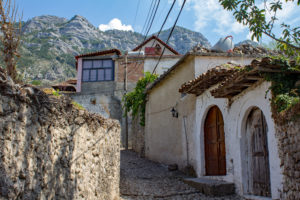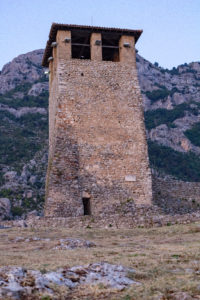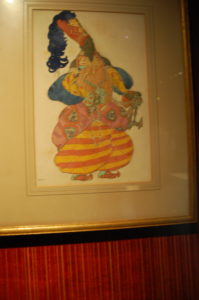From our balcony at the “Hotel Panorama”:https://www.silvertraveladvisor.com/review/accommodation/200192-review-hotel-panorama-kruja in Kruja, Albania, we had a superb view of the Castle. It looked quite a distance perched on a hill, but surprisingly was only a 15-minute walk through the Ottoman Bazaar and onwards past restaurants and bars.
Archaeological excavations prove the hill had been inhabited from the 3rd century AD with the castle being built between the 5th and 6th centuries.
Unlike many of the castles and fortresses in Albania, Kruja is unusual as it is still inhabited, and the family of our guide ‘Mary’ (Merita Dollma – a geographer and lecturer at the University of Tirana) had lived in the castle for generations.
To dispel any assumptions we might have, she quickly explained that Albanian castles were “fortified structures rather than places for posh people to live in”. At the gate, we were introduced to her elderly father, sat on a wall selling a variety of books including one written by his daughter ‘Albanian Regions’.
We were told that few British tourists venture to Albania and that more British and German tourists had visited during the communist era. We were surprised at this statement, as we’d thought the country was ‘closed’ during the communist era from 1946 to 1990. However, later in our Albanian tour we subsequently found that tourists did visit, but that they were very tightly controlled by the secret police, the sigurimi.
During the era of Skanderbeg, their national hero, the castle became the HQ of the Albanian resistance against the Ottoman Invaders. Today, the castle complex houses the Historical Museum and Ethnographic Museum which have been reviewed separately.
However, the complex, which is free, is pleasant for wandering around, especially when your guide tells you stories of how she’d watched the museum being built and points out trees and bushes planted by her father and areas where she’d played as a child.
We viewed the old mosque ruins, the mosque of Sultan Mehmet Fatih, and hammam which would have served the castle after the Ottoman invasion. It had been constructed between 1479 and 1490, damaged in 1831 by the Ottomans during an attack, but reconstructed, six years later. The mosque and the minaret had been structurally linked without any fusion.
In an area often missed by tourists due to its more isolated location on the southwestern perimeter, was the Bektashi Dollma teqe. Built in 1770, it is one of the oldest in the country. Bektashism is Albania’s fourth religion, which Mary described as a liberal form of Islam. During Albania’s atheist period from 1967, the teqe was used for storage (we later discovered that religious buildings were used for many purposes: cinemas, sports halls, and storage for weapons, potatoes etc.). However, the local people managed to have it proclaimed as a ‘Cultural Monument’ which prevented the frescoes from being destroyed by the communists. When the religious ban was lifted, the teqe was restored. It contains the triangular shaped tombs of babas (or fathers) covered in green material and woven cloths. Mary told us her family had significant interests in the teqe (I realised afterwards her surname was Dollma). Despite a sign asking us to remove shoes, she told us we were fine, but this resulted in a slight altercation with the man looking after the building.
In the teqe grounds was a 500-year-old olive tree, said to have been planted by Skanderbeg, on his wedding day. This created a tradition that every young couple should plant a tree as a sign of peace and harmony in their marriage.
Nearby, were the homes of the 11 remaining families who still live in the castle. Wandering through the maze of steep, narrow cobbled paths, we saw that many other houses had just been abandoned and were now derelict. However, one enterprising owner, was restoring their house and converting it into a small B&B. We could imagine this been a great success and others quickly following.
At the opposite end of the castle was a large lookout tower, used as a signalling post, as beacons running down the length of Albania were Skanderbeg’s method of communication.
Whilst taking a break from the sun under the shade of a large spreading poplar tree, we’d met Mary’s sister-in-law, Violetta, who invited us back to the family home for refreshments. Having followed Mary’s example and removed our shoes (!), we were led into the comfortable first floor living area and served a home-made, refreshing red berry fruit drink and sweet caramelized figs. It rounded off our castle visit royally.










